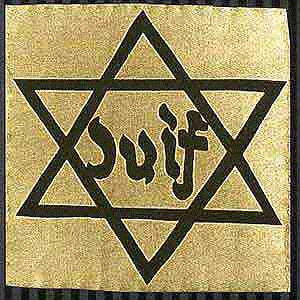|

|
|
| During the World War II there were many ghettos. One
of them is called the Warsaw ghetto. The Warsaw ghetto was the
largest and deadliest ghetto out of all of them. In the Warsaw
ghetto you couldn't bring food into the ghetto and when you were in
it you barely got any food. Anyway people died of starvation
everyday. Living in the ghetto was a horrible place. If you
didn't die in the ghettos from starvation or illness then you were sent to
the concentration camps, and they were not any better. |
| A ghetto is a walled quarter in Europe to which the Jews
were restricted in the middle ages. The ghettos were filled with
Jews from the cities and the villages. But before the Jews were put
in the ghettos, most of them had already been suffering from
starvation. Many thought that if you can survive the 1st year, then
you can survive the war, but that was not true. Most of the ghettos
were established by the Nazis. The ghettos were located by large
cities and railroad lines. Mainly all the ghettos were established
before the mass killing in 1941. The Nazis wanted Jews out of Europe
for life. The Jews lost all their factories, shops, and farms.
The Jews that survived were let out if they could prove that they would
leave the country. The Jewish kids 12 and younger had to wear
the Star of David. |

|
|
|
| "In the ghetto there was a small ghetto and a large
ghetto " remembers Hirsh Altusky a survivor of the Holocaust.
There was no food, clothes, just pure hunger and starvation," says
Erwin Baum, also a survivor of the Holocaust. The ghettos were
overly crowed by many families, thousands of people lived in the
streets. Jews died from disease and hunger. While Jews lived in the
ghettos the schools were closed and so the kids had to teach other
kids. If they were caught teaching or got caught being taught they
were killed. The Warsaw ghetto was not only the largest but the most
uprising. Some Jews were able to escape and join existing
forces. On food wise they were only allowed to have 184 calories a
day, that was only 7.5% of the daily requirement. Putting Jews in
the ghettos was Hitler's ideal of the Final Solution. The Jews were
forced to live in the ghettos. The ghettos were filthy and were in
short supply of food. The Warsaw Ghetto was established on October
2, 1940 and then six weeks later it was sealed with walls. Before
the Jews entered the ghettos they were searched by the German
police. |
| |
| Life in the Warsaw ghetto was poor. The area was
poor, too. The ghettos were a temporary place for holding Jews. The
Jews lived in fear of liquidation. They had to work for food and if
they didn't they starved to death. The woman and children usually
embroidered the Nazis symbol to the uniforms. The office workers received
more food than any of the factory workers and the people thought that it
wasn't fair. The people in the ghettos did not have medicine to help
them get better if they were sick or ill. The ghettos were usually
ran by the Jewish Regimes. If you were ill or not working then you
were deported from the ghetto. The bloody history of the Warsaw
ghetto with Jews on May 10, 1943. The survivors of the Holocaust
still keep their stories alive ... FOREVER. Over 300,000 Jews were
helpless and lonely. They could not work in places that they earned
over 500 zlotys or more a month. The Jews lived in fear because
hunger increased daily. The Jews decided they should not go easily
and they fought to survive. They also formed a small army and they
hid till it was time for revolution. |
| |
| Examples of ghettos are like the Sobibor ghetto and
Treblinka. In all these ghettos the Jews were forced to live on 180g
of bread a day, 220g of sugar a month, and 1kg of jam and honey a
day. That did not cover even 10% of the daily requirement needed to
survive. While the Jews were in the ghettos they couldn't withdraw anything
from the banks except 200 zlotys (zlotys are what they call their money) a
month. "On January 24, 1940 all the synagogues and houses of
worship were closed and all the Jews were transferred into the
ghettos." |
| |
| |
| The Jews had a hard time, kind of like the Great
Depression but only it was The Jews and they were trapped in these ghettos
and couldn't get out. Most of the Jews died! |
|
| |

